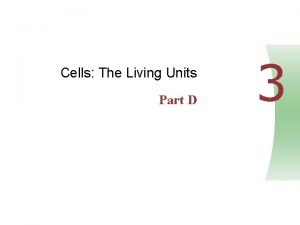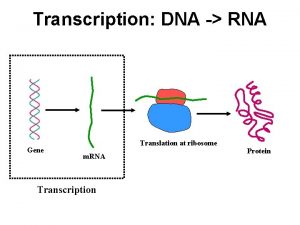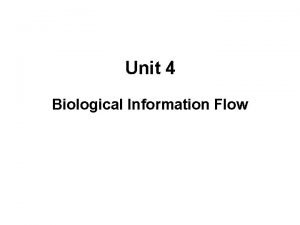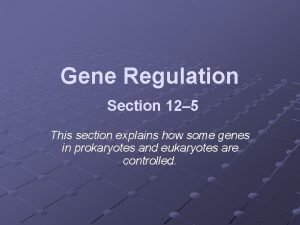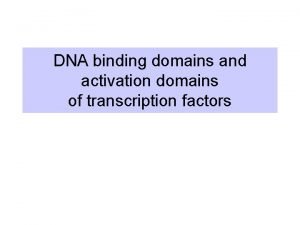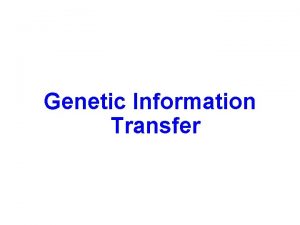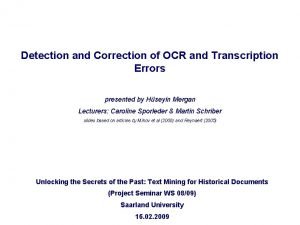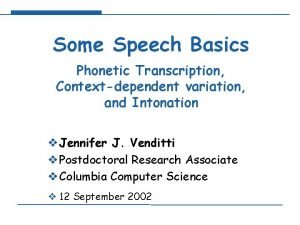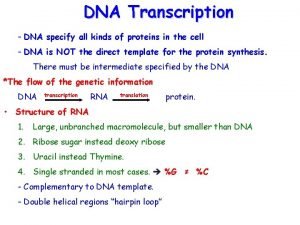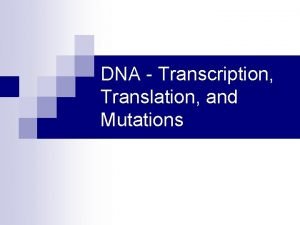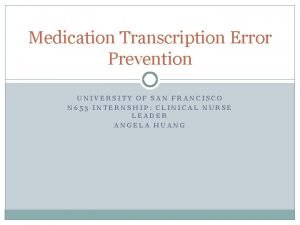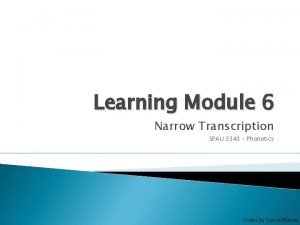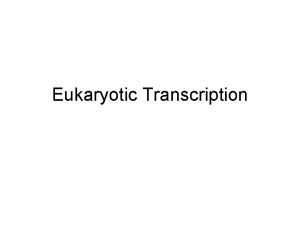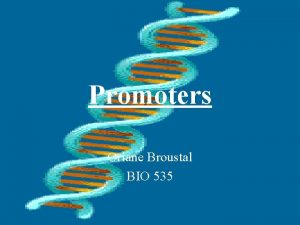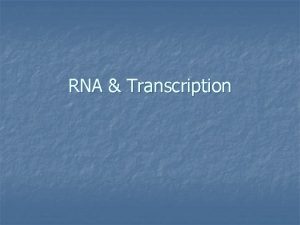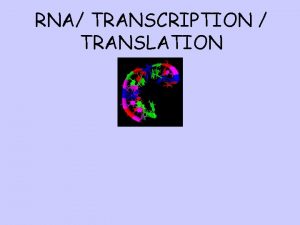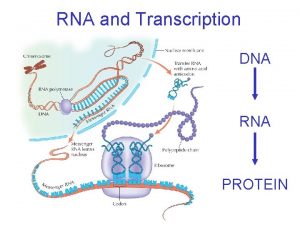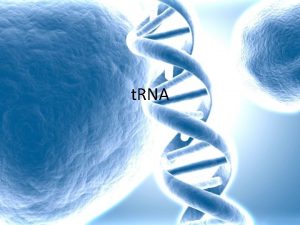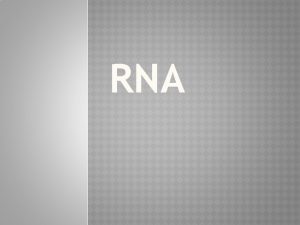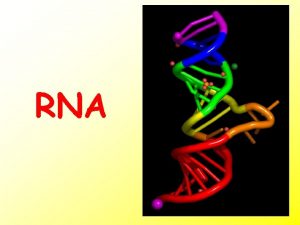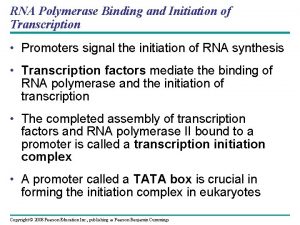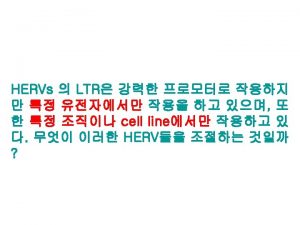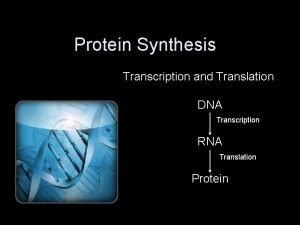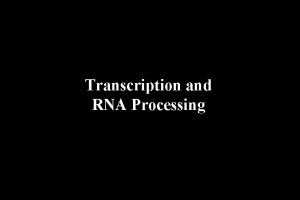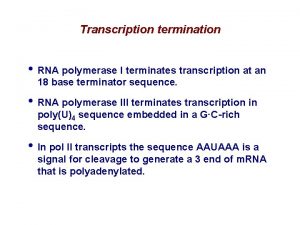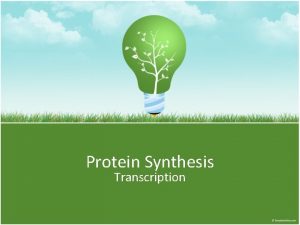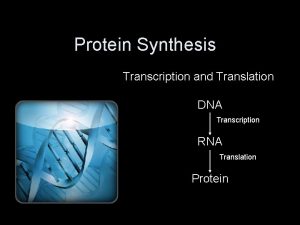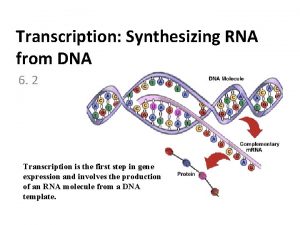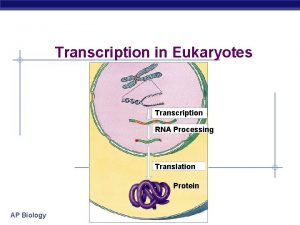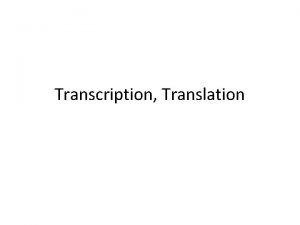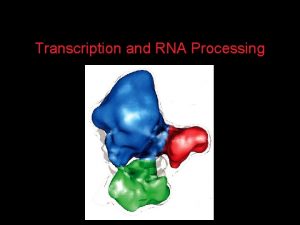TRANSCRIPTION v PROMOTERS v TRANSCRIPTION FACTORS v RNA


























- Slides: 26

TRANSCRIPTION v PROMOTERS v TRANSCRIPTION FACTORS v RNA SPLICING

INTRODUCTION • The genetic material is stored in the form of DNA in most organisms. • In humans, the nucleus of each cell contains 3 × 109 base pairs of DNA distributed over 23 pairs of chromosomes, and each cell has two copies of the genetic material. This is known collectively as the Human genome. The human genome contains around 30 000 genes, each of which codes for one protein. • Large stretches of DNA in the human genome are transcribed but do not code for proteins. These regions are called introns and make up around 95% of the genome.

Introns or the intervening sequence are considered as the non-coding part of the genes, while the Exons or the expressed sequence are known to be as the coding part for proteins of the genes. Introns are the common attribute found in the genes of the multicellular eukaryotes like humans, while exons are found in both prokaryotes and eukaryotes.

Central Dogma of Molecular Biology In this process, information flows from DNA → RNA → protein, a directional relationship known as the central dogma of molecular biology. The process by which DNA is copied to RNA is called transcription, and that by which RNA is used to produce proteins is called translation.

Ø Transcription is the first step in gene expression, in which information from a gene is used to construct a functional product such as protein. The goal of transcription is to make a RNA copy of a gene's DNA sequence. In transcription, a region of DNA opens up. One strand, the template strand, serves as a template for synthesis of a complementary RNA transcript. The other strand, the coding strand, is identical to the RNA transcript in sequence, except that it has uracil (U) bases in place of thymine (T) bases. Ø Translation involves “decoding” a messenger RNA (m. RNA) and using its information to build a polypeptide, or chain of amino acids. Translation takes place inside structures called ribosomes, which are made of RNA and proteins. Ribosomes organize translation and catalyze the reaction that joins amino acids to make a protein chain.


TRANSCRIPTION Transcription is the process by which DNA is copied (transcribed) to m. RNA, which carries the information needed for protein synthesis. Ø It is performed by enzymes called as RNA Polymerase, which link nucleotides to form an RNA strand (using DNA strand as a template). Ø Transcription has 3 stages: Initiation, Elongation & Termination Ø In Eukaryotes, RNA molecule must be processed after transcription , i. e. they are spliced and have a 5’ cap and Poly-A tail put on other end 3’.

RNA Polymerase RNA polymerases are enzymes that transcribe DNA into RNA. Using a DNA template, RNA polymerase builds a new RNA molecule through base pairing. For instance, if there is a G in the DNA template, RNA polymerase will add a C to the new, growing RNA strand. RNA polymerase always builds a new RNA strand in the 5’ to 3’ direction. RNA polymerases are large enzymes with multiple subunits, even in simple organisms like bacteria. In addition, humans and other eukaryotes have three different kinds of RNA polymerases: I, II, and III.

Step 1. Initiation § To begin transcribing a gene, RNA polymerase binds to the specific DNA sequence, these regions are called as Promoter. Basically, the promoter tells the polymerase where to "sit down" on the DNA and begin transcribing. § Each gene has its own promoter. A Promoter contains DNA sequences that let RNA polymerase or its helper proteins attach to the DNA. Once the transcription bubble has formed, the polymerase can start transcribing.

Promoters in Bacteria: How a promoter works? A typical bacterial promoter contains two important DNA sequences, the -10 and -35 elements. RNA polymerase recognizes and binds directly to these sequences. The sequences position the polymerase in the right spot to start transcribing a target gene, and they also make sure it's pointing in the right direction. Once the RNA polymerase has bound, it can open up the DNA and get to work. DNA opening occurs at the -10 element, where the strands are easy to separate due to the many As and Ts (which bind to each other using just two hydrogen bonds, rather than the three hydrogen bonds of Gs and Cs). The minus signs just mean that they are before, not after, the initiation site.

Promoters in humans In eukaryotes like humans, the main RNA polymerase in the cells does not attach directly to promoters like bacterial RNA polymerase. Instead, helper proteins called basal (general) transcription factors bind to the promoter first, helping the RNA polymerase in the cells get a foothold on the DNA. Many eukaryotic promoters have a sequence called a TATA box. The TATA box plays a role much like that of the -10 element in bacteria. It's recognized by one of the general transcription factors, allowing other transcription factors and eventually RNA polymerase to bind. It also contains lots of As and Ts, which make it easy to pull the strands of DNA apart.

Step II. Elongation § Once RNA polymerase is in position at the promoter, the next step of transcription—elongation—can begin. Basically, elongation is the stage when the RNA strand gets longer, by the addition of new nucleotides. § During elongation, RNA polymerase "walks" along one strand of DNA, known as the template strand (3’-5’), in the 5' to 3' direction. § For each nucleotide in the template, RNA polymerase adds a matching (complementary) RNA nucleotide to the 3' end of the RNA strand. § The RNA transcript is nearly identical to the non-template, or coding, strand of DNA, rather possess base uracil (U) in place of thymine (T).

Step III. Termination • RNA polymerase will keep transcribing until it gets signals to stop. The process of ending transcription is called termination, and it happens once the polymerase transcribes a sequence of DNA known as a terminator. Termination in bacteria There are two major termination strategies found in bacteria: Rho-dependent and Rho-independent. Ø In Rho-dependent termination, the RNA contains a binding site for a protein called Rho factor binds to this sequence and starts "climbing" up the transcript towards RNA polymerase.

• When it catches up with the polymerase at the transcription bubble, Rho pulls the RNA transcript and the template DNA strand apart, releasing the RNA molecule and ending transcription. Another sequence found later in the DNA, called the transcription stop point, causes RNA polymerase to pause and thus helps Rho catch up. Ø Rho-independent termination depends on specific sequences in the DNA template strand. As the RNA poly. approaches the end of the gene being transcribed, it hits a region rich in C and G nucleotides. The RNA transcribed from this region folds back on itself, and the complementary C and G nucleotides bind together. The result is a stable hairpin that causes the polymerase to stall which is followed by a stretch of U nucleotides in the RNA, which match up with A nucleotides in the template DNA. The complementary U-A region of the RNA transcript forms only a weak interaction with the template DNA. This, coupled with the stalled polymerase, produces enough instability for the enzyme to fall off and liberate the new RNA transcript.

Transcription in Eukaryotes In Eukaryotes, transcription takes place in two broad steps: Firstly, pre-messenger RNA is formed, with the involvement of RNA polymerase enzymes. The process relies on Watson-Crick base pairing, and the resultant single strand of RNA is the reverse-complement of the original DNA sequence. Secondly, The pre-messenger RNA is then "edited" to produce the desired m. RNA molecule in a process called RNA splicing.

1. Formation of pre-messenger RNA: • The mechanism of transcription has parallels as that of DNA replication. • Partial unwinding of the double helix must occur before transcription can take place, and it is the RNA polymerase enzymes that catalyze this process. • In DNA replication, the strand that contains the gene is called the sense strand, while the complementary strand is the antisense strand. The m. RNA produced in transcription is a copy of the sense strand, but it is the antisense strand that is transcribed. • Ribonucleotide triphosphates (NTPs) align along the antisense DNA strand, with Watson-Crick base pairing (A pairs with U).

• RNA polymerase joins the ribonucleotides together to form a pre-messenger RNA molecule that is complementary to a region of the antisense DNA strand. • Transcription ends when the RNA polymerase enzyme reaches a triplet of bases that is read as a "stop" signal. The DNA molecule re-winds to re-form the double helix. Representation of the formation of pre-messenger RNA (orange) from doublestranded DNA (blue) in transcription.

2. RNA splicing: The pre-messenger RNA thus formed contains introns which are not required for protein synthesis. The pre-messenger RNA is chopped up to remove the introns and create messenger RNA (m. RNA) in a process called as RNA splicing. Eukaryotic pre-messenger RNA Processing

Promoter: Promoter is a region of DNA that initiates transcription of a particular gene. Promoters are located near the transcription start sites of genes, on the same strand upstream on the DNA (towards the 3' region of the anti-sense strand). Promoters can be about 100– 1000 base pairs long. For transcription to take place, the enzyme that synthesizes RNA, known as RNA polymerase, must attach to the DNA near a gene. Promoters contain specific DNA sequences such as response elements that provide a secure initial binding site for RNA polymerase and for proteins called transcription factors that recruit RNA polymerase. These transcription factors have specific activator or repressor sequences of corresponding nucleotides that attach to specific promoters and regulate gene expression.

Promoters in Bacteria: In bacteria, promoter is recognized by RNA polymerase and an associated sigma factor, which in turn are often brought to the promoter DNA by an activator protein's binding to its own DNA binding site nearby. How a promoter works? A typical bacterial promoter contains two important DNA sequences, the -10 and -35 elements. RNA polymerase recognizes and binds directly to these sequences. The sequences position the polymerase in the right spot to start transcribing a target gene, and they also make sure it's pointing in the right direction. Once the RNA polymerase has bound, it can open up the DNA and get to work. DNA opening occurs at the -10 element, where the strands are easy to separate due to the many As and Ts (which bind to each other using just two hydrogen bonds, rather than the three hydrogen bonds of Gs and Cs). The minus signs just mean that they are before, not after, the initiation site.

In eukaryotes, the process is more complicated, and at least seven different factors are necessary for the binding of an RNA polymerase II to the promoter. A promoter is induced in response to changes in abundance or conformation of regulatory proteins in a cell, which enable activating transcription factors to recruit RNA polymerase. 1. Core Promoter – the minimal portion of the promoter required to properly initiate transcription. • Includes the transcription start site (TSS) and elements directly upstream • A binding site for RNA polymerase • RNA polymerase I: transcribes genes encoding 18 S, 5. 8 S and 28 S r-RNAs • RNA polymerase II: transcribes genes encoding m-RNA and certain small nuclear RNAs and micro RNA • RNA polymerase III: transcribes genes encoding t-RNA, 5 s r-RNAs and other small RNAs. • General transcription factor binding sites, e. g. TATA box 2. Proximal Promoter – the proximal sequence upstream of the gene that tends to contain primary regulatory elements. • Approximately 250 base pairs upstream of the start site. • Specific transcription factor binding sites 3. Distal promoter – the distal sequence upstream of the gene that may contain additional regulatory elements, often with a weaker influence than the proximal promoter. • Anything further upstream (but not an enhancer or other regulatory region whose influence is positional/orientation independent) • Specific transcription factor binding sites

Transcription factor (TF) (or sequence-specific DNAbinding factor) • It is a protein that controls the rate of transcription of genetic information from DNA to m-RNA, by binding to a specific DNA sequence. § The function of TFs is to regulate—turn on and off—genes in order to make sure that they are expressed in the right cell at the right time and in the right amount throughout the life of the cell and the organism. § Groups of TFs function in a coordinated fashion to direct cell division, cell growth, and cell death throughout life; cell migration and organization (body plan) during embryonic development. § There are up to 2600 TFs in the human genome. § TFs work alone or with other proteins in a complex, by promoting (as an activator), or blocking (as a repressor) the recruitment of RNA polymerase to specific genes. § Important feature of TFs is that they contain at least one DNA-binding domain (DBD), which attaches to a specific sequence of DNA adjacent to the genes that they regulate. § TFs are grouped into classes based on their DBDs. Other proteins such as coactivators, chromatin remodelers, histone acetyltransferases, histone deacetylases, kinases, and methylases are also essential to gene regulation, but lack DNA-binding domains, and therefore are not TFs.


How do transcription factors work? A typical transcription factor binds to DNA at a certain target sequence. Once it's bound, the transcription factor makes it either harder or easier for RNA polymerase to bind to the promoter of the gene. a. Activators Some transcription factors activate transcription. For instance, they may help the general transcription factors and/or RNA polymerase bind to the promoter.

b. Repressors Other transcription factors repress transcription. This repression can work in a variety of ways. For example, a repressor may get in the way of the basal transcription factors or RNA polymerase, making it so they can't bind to the promoter or begin transcription.

c. Binding sites The binding sites for transcription factors are often close to a gene's promoter. However, they can also be found in other parts of the DNA, sometimes very far away from the promoter, and still affect transcription of the gene. The flexibility of DNA is what allows transcription factors at distant binding sites to do their job. The DNA loops like cooked spaghetti to bring far-off binding sites and transcription factors close to general transcription factors or "mediator" proteins.
 Dna to rna transcription
Dna to rna transcription Ribosomem
Ribosomem Transcription and translation venn diagram
Transcription and translation venn diagram Rna transcription
Rna transcription Section 12-5 gene regulation
Section 12-5 gene regulation Keep satisfied manage closely monitor keep informed
Keep satisfied manage closely monitor keep informed Chapter 8 employment labor and wages
Chapter 8 employment labor and wages Articulating a vision
Articulating a vision What is tourism
What is tourism Activation domain of transcription factors
Activation domain of transcription factors Location situation
Location situation Site vs situation
Site vs situation Is tulip biotic or abiotic
Is tulip biotic or abiotic Biotic and abiotic environment
Biotic and abiotic environment Factor of 32
Factor of 32 Abiotic factors and biotic factors
Abiotic factors and biotic factors What are the factors of 7
What are the factors of 7 Aboitic environment
Aboitic environment What are the factors of 8
What are the factors of 8 Central dogma
Central dogma Hüseyin mergan
Hüseyin mergan Tomb phonetic transcription
Tomb phonetic transcription Dna transcription
Dna transcription Translation
Translation Transcription error
Transcription error Broad and narrow transcription
Broad and narrow transcription Eukaryotic transcription
Eukaryotic transcription
